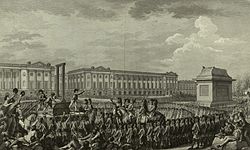Contents
- Incumbents
- Events
- January to June
- July to September
- October to December
- Ongoing
- Births
- Deaths
- January to September
- October
- November
- December
- See also
- References
| |||||
| Decades: | |||||
|---|---|---|---|---|---|
| See also: | Other events of 1793 History of France • Timeline • Years | ||||
Events from the year 1793 in France .




